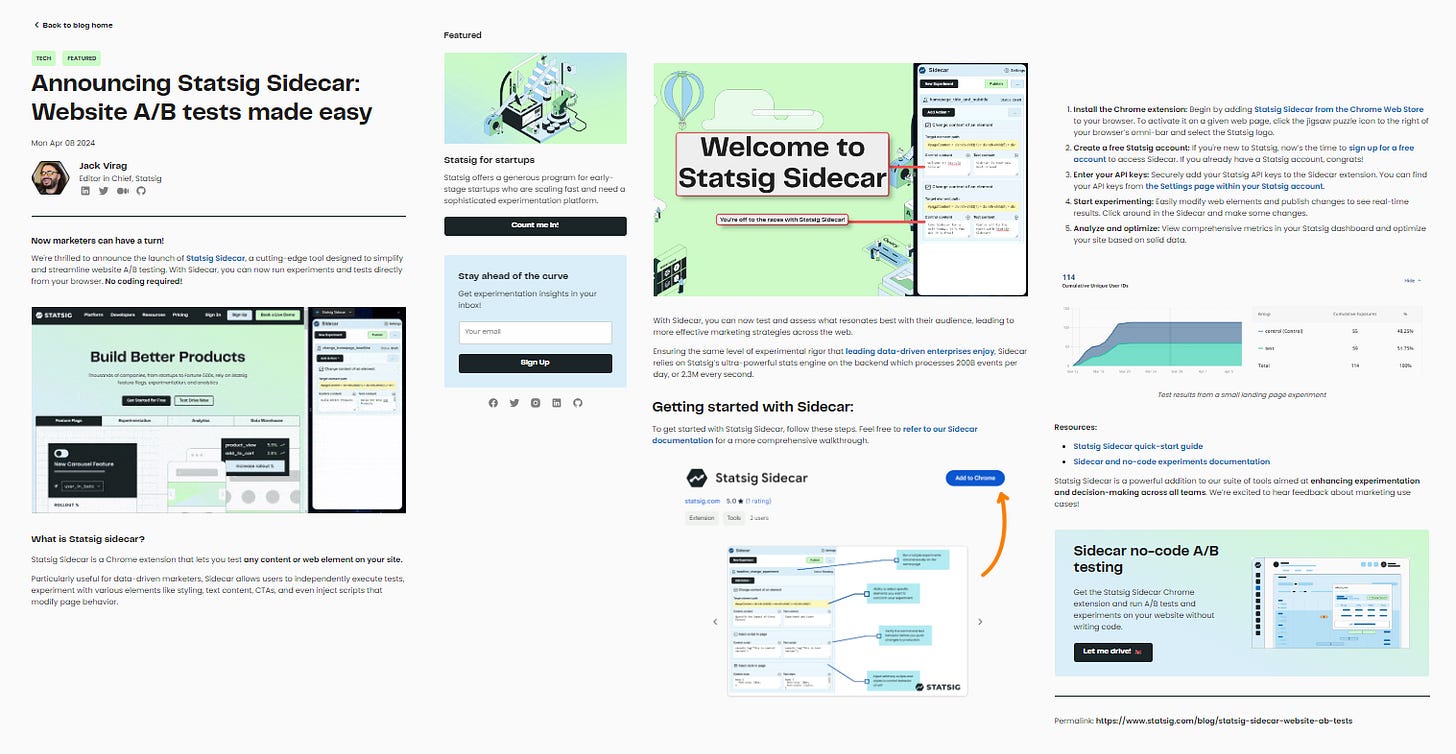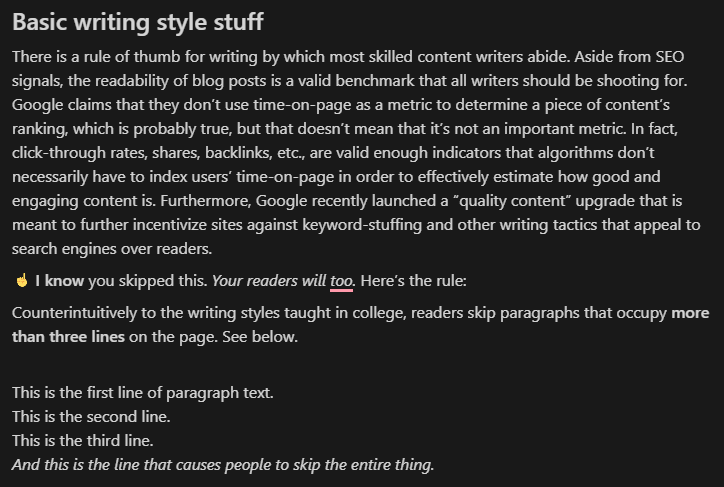How to add human flair to your AI writing
Since you're probably gonna do it anyway, here's how to do it right.
When you’re trying to get a Saas company off the ground, you’re going to need lots of content…usually about 4x what your capacity for content creation is.
⚠️ Author’s Note: I use Scout for AI blog drafts. It writes TOFU content using our tech docs as a source. While vanilla AI content isn’t good without a human touch, Scout’s is by far the best you’ll get.
The problem with most AI-generated content is that it isn’t punchy. As I’ve often said, traditional SEO tactics like keyword stuffing are slowly diminishing in favor of more intelligent signals that more closely align with user behavior.
Generally speaking, AI content is good for breaking down steps and teaching stuff, but it still requires a bit of work to turn it into something compelling, memorable, shareable, entertaining, etc.—all the things that high-quality content should be.
Assuming you don’t have a super-customized version of Scout like I do, your AI content is going to be bad. This is how to make it better.
Common AI content telltales
To an experienced editor like myself, AI content is detectable 2 sentences in. Here are some of the things I look for:
Uniform sentence length
AI doesn’t have short sentences. It doesn’t have long sentences either, except for rare occasions. It’s pretty obvious that most LLMs are trained to try to adhere to a given sentence length, and that makes the content read very boringly.
^ AI would never write this.
Overuse of listicles
Because LLMs are supposed to give users a clean summary of information, they overindex on listicles. They commonly do this with ordered or unordered lists with bold text, and then a colon connecting an elaboration. Here’s an example:
AI loves lists: All of its content will have sections that look like this.
Not terrible: While this format is pretty good for summaries, almost all pieces of AI writing will index heavily on this format.
Shitty intros
Your hook sentence is supposed to draw readers’ attention. I consider them a throwback to the days of magazines, when content actually had to be good in order to get read. In fact, on the Statsig blog, we write our hook sentences in H4, and always make them at least a little punchy.
AI intros are almost always something like “In the world of [broad topic], [exact keyword] plays an important role.”
New grad formatting
Wherever possible, AI will start each paragraph with a topic sentence, and end each paragraph with a conclusion sentence. Paragraphs are generally 3-5 sentences, all of uniform length.
The motion of reading an AI-generated article makes you feel seasick.
I call this new grad formatting because it’s very reminiscent of the way people are formally taught in school. After you’ve written a bunch of blog posts, you’ll find that your less-formatted articles perform better.
Way too many conclusions!
As if conclusion sentences at the end of each paragraph or section weren’t enough, AI posts always end with a dedicated conclusion section, usually under the heading “In Conclusion,” wherein the entire post is shittily wrapped up and boringly summarized.
I just delete these. No good posts end like this. Come on.
Weird sales pitches
Just delete these and embed CTAs instead. Let your content just be content.
What good content looks like
Good content:
Is funny, fun, entertaining, or novel, if possible
Teaches the reader something
My mentor, Ben Goldstein, always says, “Readers should be able to print your article and use it as a guide.”
He used to write for an adult magazine, and anyone whose writing can compete for attention against adult photos must be a really f*ing good writer.
Uses paragraphs that are three lines (<br>s) of text, otherwise readers will skip them
Doesn’t conclude or repeat itself
Is skimmable; each section provides its own standalone value, because that’s how readers read web content
Is written for people, not search engines
Has a good “hook”
Has an angle or opinion that relies on author experience
Has pics
Has headings that make sense
H2s relate to the overall topic, H3s relate to their H2’s topic
How to make your AI content sound more human
If you use an AI tool, even with some good prompt engineering, your content is going to suffer from the telltales listed above.
Here’s how to change those:
Rewrite the intro in its entirety
Humans throw punches; robots don’t (foreshadowing???). Your hook sentence is a chance to give a TLDR, or use the information gap to get readers excited to learn more.
I’d advise having the hook sentence be a standalone sentence, written in H4. I did one in this post.
Break up paragraphs
Again, paragraphs should be less than three lines of text.
You can use this post as an example. While it’ll render differently on everyone’s screens, I’ve at least made sure, here in the Substack editor where I draft posts, that I only have one paragraph that is longer than three lines.
This has to do with the human attention span. Generally, no one’s going to be super interested in reading your post unless they’re using it as a guide. Psychologically, readers are choosing their battles when engaging with your content.
Long paragraphs are a “big battle,” and readers will just skip them unless they’re super invested. Someone needs to tell LLMs this!
Add pics
A picture is worth a bunch of words, I forget exactly how many.
As far as content goes, pictures are a writing tool. You can use them to express concepts more easily, or to present an additional layer of context to help readers understand a concept.
Your AI writing won’t have any pictures by default. Make a point to scour your site/app/product/the internet at large for images that you can add to your post.
They also help to break up monotonous content a bit.
Delete the conclusions
Readers form their own conclusions as they read. An entire section devoted to this? Disgusting. Delete that and replace it with a cool CTA.
Also be sure to remove conclusion sentences from the ends of paragraphs, and topic sentences that serve to “warm up” a topic. That’s what your intro is for. The content itself should just be factual and concise.
Optional: Use sentence case instead of title case
Sentence case is better than title case in almost every…case.
Title case is like dressing your words in a suit. It doesn’t fool anyone into thinking you’re more authoritative. If anything, it just makes headings harder to read.
Also, in the Saas world, there are a lot of proper nouns that you’ll be writing about (ie how to integrate with another tool), and sentence case makes proper nouns easier to spot.
In conclusion
Nah, I’m just kidding! There’s never a need to “conclude” your content, because readers form their own conclusions as they read. If you really need a conclusion, DM me. I’m always happy to elaborate.
Like what you’ve read? Share this post somewhere! My mission is to make content that is helpful to scrappy Saas founders and startups, and I use subscribership as a signal.





